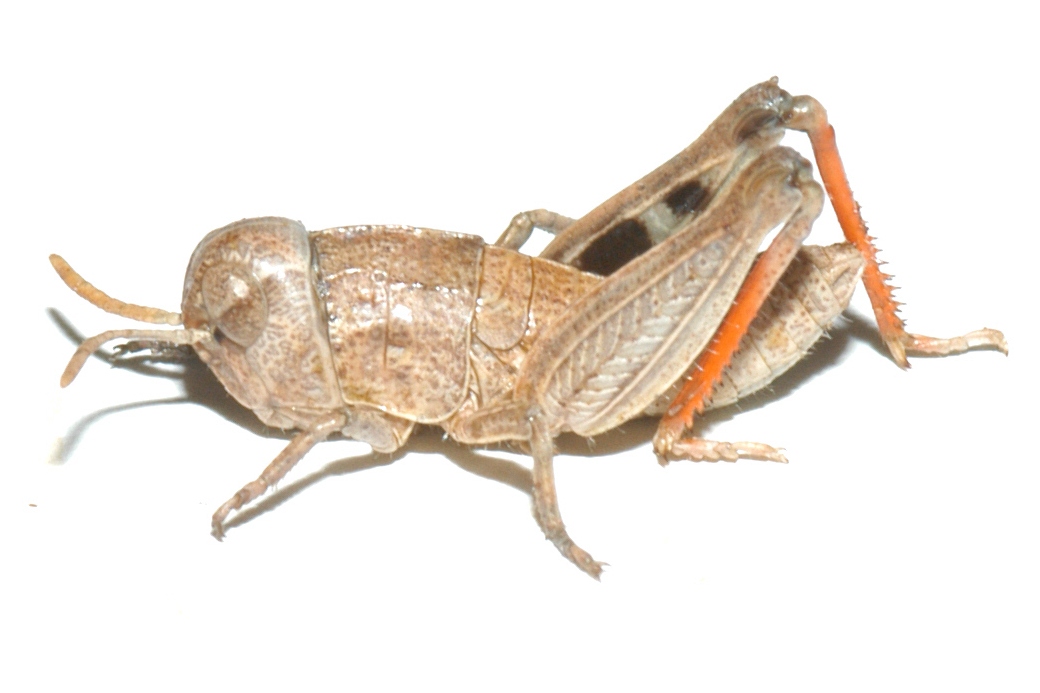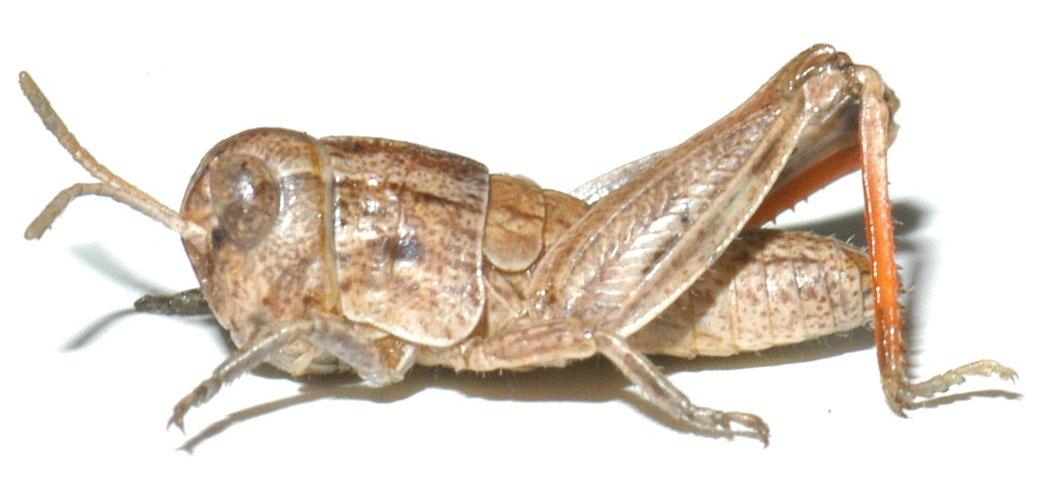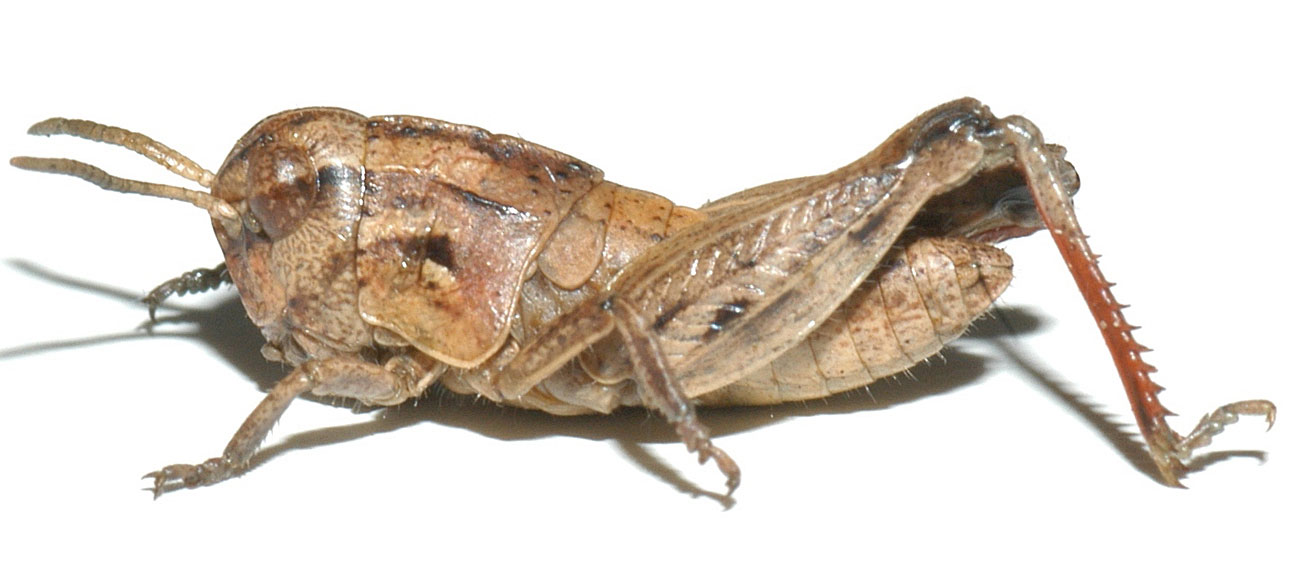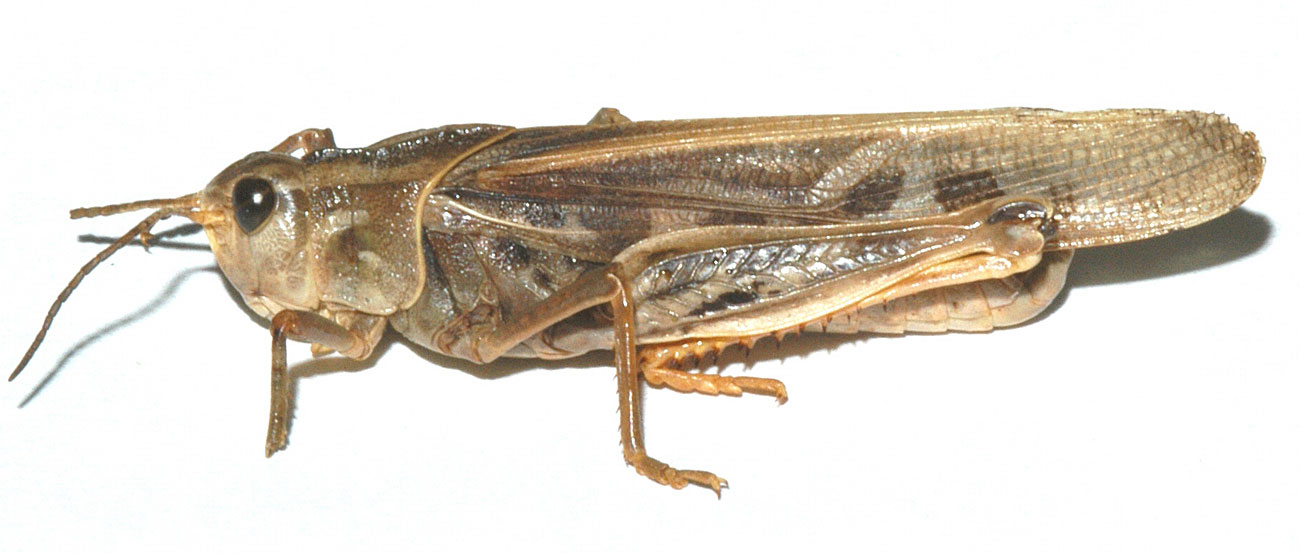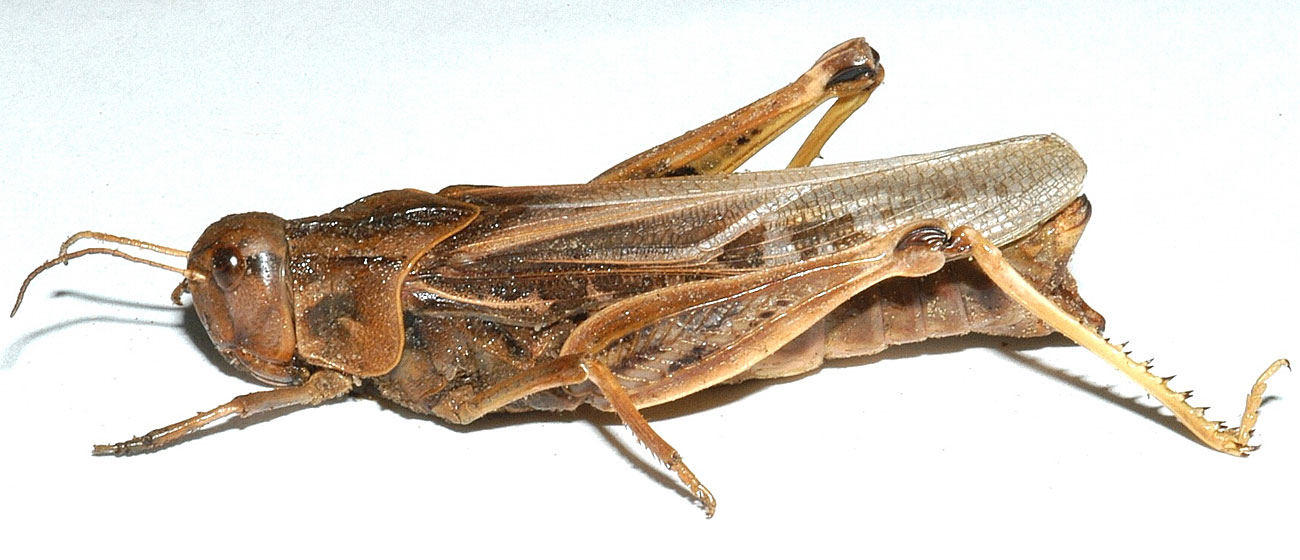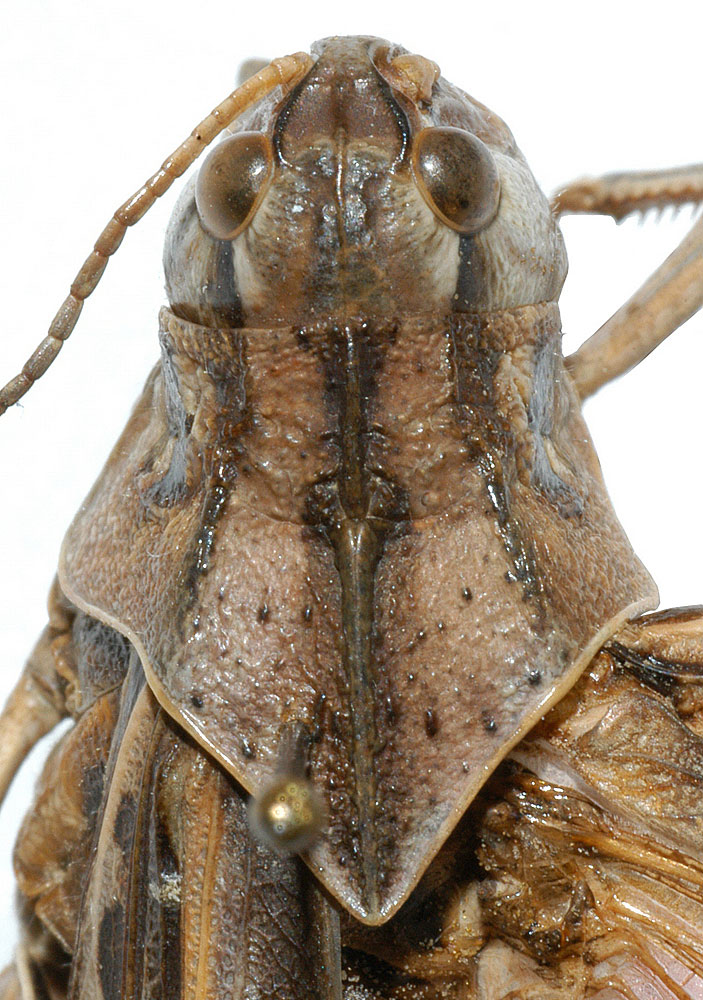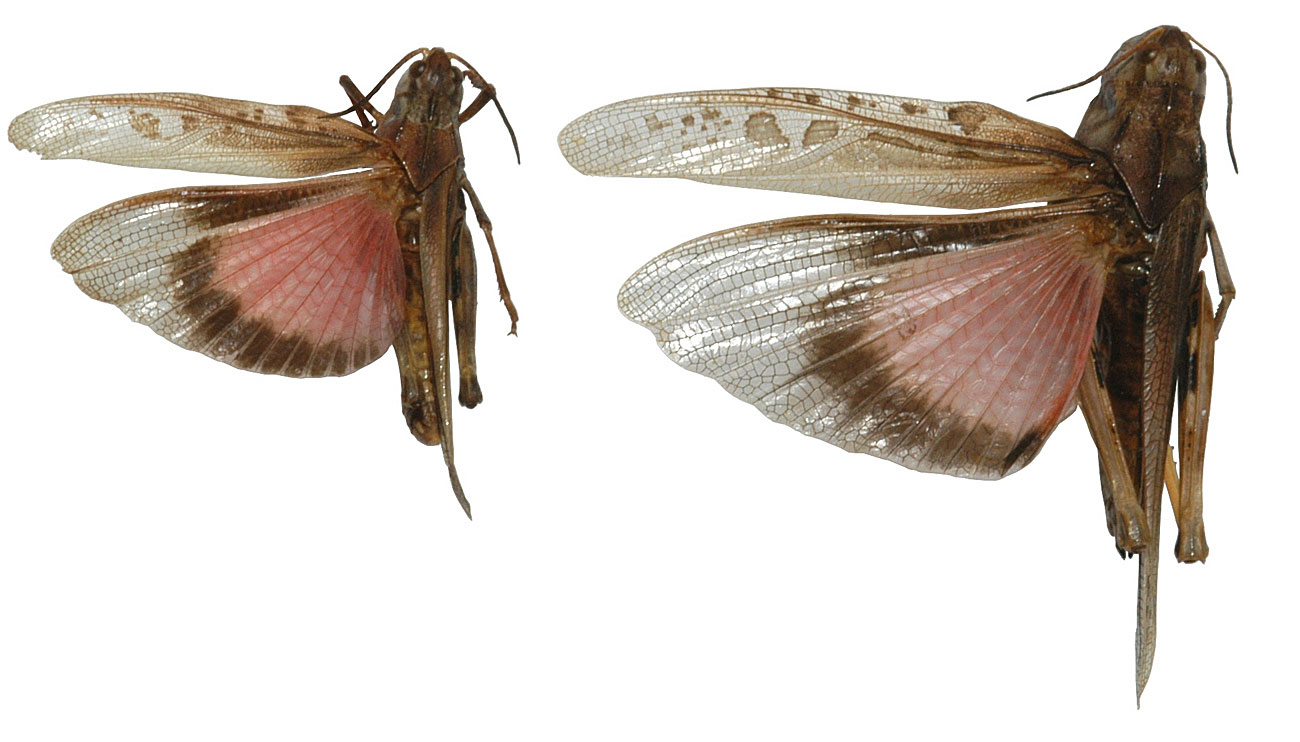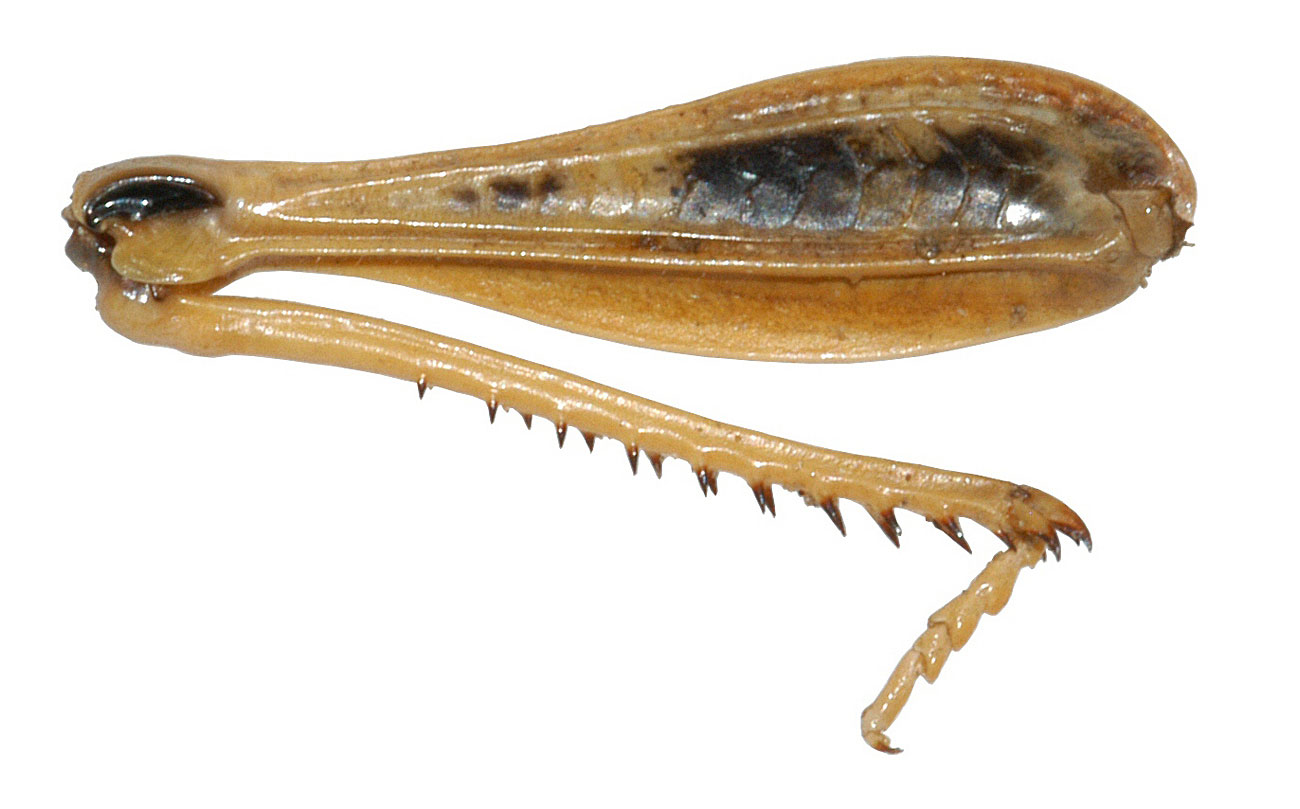Pardalophora apiculata
|
Geographic range of Pardalophora apiculata (Harris) |
|
Fig. 1, second instar: BL 6-9.5 mm, FL 4-6.5 mm, AS 13-15 |
|
Fig. 2, third instar: BL 8-12.5 mm, FL 5.5-8 mm, AS 15-18 |
|
Fig. 3, fourth instar: BL 13-17 mm, FL 6.5-10 mm, AS 19-23 |
|
Fig. 4, adult male: BL 28-34 mm, FL 15-20 mm, AS 22-24 |
|
Fig. 5, adult female: BL 40-46 mm, FL 22-27 mm, AS 24-28 |
|
Fig. 6, dorsal view of pronotum |
|
Fig. 7, dorsal view of coral-winged grasshopper |
|
Fig. 8, inner hind femur |
Species
Coral-winged grasshopper
Pardalophora apiculata (Harris)
Subfamily Oedipodinae
Identification
Females of this grasshopper are larger than males. Both sexes are brownish to grayish brown with various dark spots. The spotting on the tegmina is somewhat indistinct and the spots near the base are usually large and generally fused into one or a few, and those distally are generally lacking. The hind wings are always pink to reddish pink with a blackish band. The dorsal pronotum is comparatively smooth for species in this group, with only 10 to 18 small and widely scattered pustules and no distinct ridges. The median carina is cut by one (rarely two) suclus. The median dark band on the pronotum covers less than one-third of the dorsal pronotal surface. The outer surface of the hind femur is brown, most often with two dark bands, but the dark bands are occasionally lacking. The inner hind femur is orange with black areas covering at least one-fifth of the inner surface. These dark patches may be somewhat diffuse or largely merged into a single patch, but are always most well developed basally. The hind tibiae are pale brown to orange.
Distribution and habitat
The coral-winged grasshopper ranges from northwestern Canada and southern Quebec to North Carolina, Oklahoma, Colorado, and Montana. It inhabits grassy areas on dry and sandy soils as well as upland meadows. In Canada it has been found in parklands and in clearings in coniferous woodlands as well as on light sandy soil covered with long grass and various other plants. In New England it inhabits upland pastures, abandoned fields, and unimproved areas often somewhat overgrown with weeds and bushes. In Nebraska it can be found on both loess and sandy soils in open rangeland as well as in areas adjacent to woodland. It occurs in small colonies and is rarely numerous.
Economic importance
Because the coral-winged grasshopper is rarely common, it is not expected to be of economic importance.
Food preferences
The food habits of this grasshopper have not been studied in great detail, but it presumably prefers grasses and sedges as has been shown in the closely related Pardalophora haldemani. Food preference tests showed that it will feed on Poa pratensis, Poa compressa, and Tragopogon pratensis.
Dispersal and migration
The dispersal of this grasshopper has not been studied. It is known to be a strong flier and is likely capable of traveling long distances.
Hatching
Nymphs most likely hatch from early July to early August.
Nymphal development
Nymphs of the coral-winged grasshopper are found from middle and late summer as well as in early spring. Overwintering normally occurs in the fourth instar. A two year life-cycle has been reported from western Canada in which case the first winter is passed in the egg stage and the second winter as a late instar. Nymphs have been collected from July to May (except for cold months) in Kansas.
Adults and reproduction
Females often hide and are reluctant to fly. Males perform display flights which are short in duration. When approaching females, males produce ordinary and vibratory stridulation. Receptive females perform a unique display on the ground which consists of spreading the hind femora and lowering the end of the abdomen toward the ground and pointing toward the approaching male. In much of its range, this is often the earliest species to be found in the adult stage. In Iowa and South Dakota it is most abundant from May to July. In Kansas adults occur from early April to early June. In Nebraska adults have been noted as early as mid-March and have been collected in numbers as early as early and mid-April. Peak numbers of adults in Nebraska are found in April and May.
Population ecology
The population ecology of this grasshopper has not been studied.
Daily activity
The daily activity of this grasshopper has not been studied in detail.
Source and date
University of Nebraska March 2007 by Mathew L. Brust
Selected references
Blatchley, W. S. 1920. Orthoptera of Northeastern America, with especial reference to the faunas of Indiana and Florida. The Nature Publishing Company, Indianapolis, Indiana. 784 pp.
Brooks, A. R. 1958. Acridoidea of southern Alberta, Saskatchewan, and Manitoba. Supplement 9, Canadian Entomologist 90: 1-92.
Gangwere, S. K. 1961. A monograph on food selection in Orthoptera. Transactions of the American Entomological Society 87: 67-230.
Hebard, M. 1925. The Orthoptera of South Dakota. Proceedings of the Academy of Natural Sciences, Philadelphia 77: 35-155.
Helfer, J. R. 1987. How to Know the Grasshoppers, Crickets, Cockroaches and Their Allies. Dover Publications Inc. New York, New York. 363 pp.
McDaniel, B. 1987. Grasshoppers of South Dakota. South Dakota Agriculture Experiment Station Publication TB 89. 163 pp.
Morse, A. P. 1920. Manual of the Orthoptera of New England. Proceedings of the Boston Society of Natural History 35: 197-556.
Otte, D. 1970. A comparative study of communicative behavior in grasshoppers. Miscellaneous Publications of the University of Michigan Museum of Zoology no. 141: 1-168.
Otte, D. 1984. The North American Grasshoppers. Volume 2, Acrididae: Oedipodinae. Harvard University Press, Cambridge, Massachusetts. 366 pp.
Smith, S. 1981. Variation in morphology and coloration among grasshoppers related to geographical distribution, seasonal occurrence, and plant communities in the Flint Hills region of Kansas. Ph.D. dissertation, Kansas State University.
Walker, E. M. 1898. Notes on some Ontario Acrididae. I. Canadian Entomologist 30: 122-126.
Walker, E. M. 1898. Notes on some Ontario Acrididae. II. Canadian Entomologist 30: 258-263.

